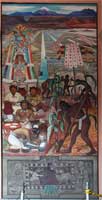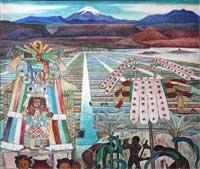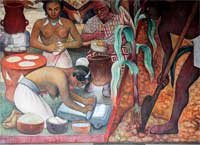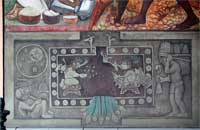


|
Cultivation and use of corn; the goddess of cornThe scene is presided over by Teocintle, tutelary spirit of corn. The background depicts the system of "chinampas" farming--fields in marshes or lakes or man-made islets for farming with furrow or canals between them. These canals carry the eye to the background with the dramatic snow-covered peak. The figure in the foreground right uses a "coa" which has a pointed end for sowing. On the left different corn dishes are made including atole, a drink made of corn meal gruel. | |
The importance of cornThe corn deity is richly dressed and holds double ears of corn in each hand. The multiple tasks of preparing corn are illustrated, including grinding corn on the age-old metate. See also Rivera's painting La Molendera (The Woman Grinder), 1924, for a similar figure. |

|

|

|
A tinted grisaille with a pictogram for waterThe word on the top border says "totopánitl" --a term referring to the corn stalk worn in ritual dances. The figures, Oxomoco and Cipactonal are the semi-divine couple who cast maize as a form of divination. Also attributed to them are the invention of the calendar, curing of illness, and the interpretation of dreams. Rodríguez says Rivera borrowed directly from the Codex Borbonicus for this representation. |
|
 Go to Rivera Murals Index.
Go to Rivera Murals Index.
 Go to the Mexico Index.
Go to the Mexico Index.
 Click here to return to index of art historical sites.
Click here to return to index of art historical sites.
 Click here to return to index of artists and architects.
Click here to return to index of artists and architects.
 Click here to return to chronological index.
Click here to return to chronological index.
 Click here to see the home page of Bluffton University.
Click here to see the home page of Bluffton University.

